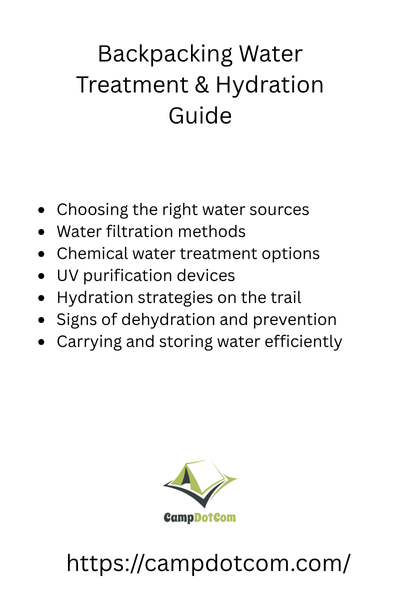So, you’re heading out on a backpacking adventure, and you know water is a big deal. But have you ever stopped to think about just how important it really is? Trust me, I learned the hard way that not all water sources are as fresh as they look.
On one of my first long hikes, I grabbed water from a crystal-clear mountain stream, only to end up with a stomach disaster that cut my trip short. Lesson learned! That’s why this backpacking water treatment and hydration guide is here to help you avoid my mistake and keep your adventure on track.
Read More About Backpacking Water Treatment & Hydration Guide

Why Water Matters More Than You Think
You can survive weeks without food, but only a few days without water. And when you’re hiking, sweating, and burning calories like crazy, dehydration sneaks up fast.
As an Amazon Associate, I earn from qualifying purchases. Some of the links in this article are affiliate links. This means that, at zero cost to you, I will earn an affiliate commission if you click through the link and finalize a purchase.
Even mild dehydration can zap your energy, mess with your focus, and make that uphill climb feel like Everest.
So, how much water do you need? The general rule is half a liter per hour in moderate temps.
Hot weather? More. High altitude? More. Heavy pack? You guessed it—more!
Finding Water in the Wild
If you’re lucky, your route will have plenty of streams, rivers, or lakes. But here’s the kicker: even the clearest water can harbor nasty bacteria, viruses, or parasites (looking at you, Giardia). That’s why treating your water is a must.
Here’s what to look for in a water source:
- Flowing water is usually safer than stagnant ponds.
- Avoid water near livestock, campsites, or human activity.
- Higher elevation sources are generally cleaner.
More Things to Know About Backpacking Water Treatment & Hydration Guide

Water Treatment Methods: Pros and Cons
So, how do you make sure your water won’t ruin your trip? Let’s break it down.
1. Boiling
Tried and true! If you’ve got a stove and time, boiling for one minute (or three at high altitudes) kills everything.
Downside? It takes fuel and patience—neither of which you may have in abundance after a long hike.
2. Filters & Purifiers
Filters, like squeeze or pump filters, remove bacteria, protozoa, and debris. Purifiers go a step further by eliminating viruses, too. Great if you’re traveling internationally or hiking in sketchy areas.
- Pros: Quick, effective, easy to use
- Cons: Can clog, require maintenance
3. UV Light Treatment
A magic wand (okay, it’s a battery-powered UV device) zaps nasties in seconds. Super convenient, but it relies on batteries, and if your water isn’t clear, you might need to pre-filter it.
4. Chemical Treatment (Tablets/Drops)
These tiny lifesavers—usually iodine or chlorine dioxide—kill almost everything, but they do take time (30 minutes to four hours). Best as a backup option.
- Pros: Lightweight, foolproof
- Cons: Slight aftertaste, waiting time
Hydration Hacks for Backpackers
Even if you’re drinking enough, you might not be absorbing it efficiently. A few tricks to keep you hydrated and energized:
- Sip consistently instead of chugging huge amounts at once.
- Add electrolytes (powders, tablets, or even salty snacks) to keep your sodium and potassium levels balanced.
- Start your day hydrated—don’t play catch-up when you’re already thirsty.
- Use a hydration bladder for easy access to water without stopping.
My Favorite Hydration Gear
If you’re wondering what’s in my pack, here’s my go-to setup:
- Sawyer Squeeze Filter – Lightweight, reliable, and easy to use.
- Hydration bladder (2L) – Encourages frequent sipping without hassle.
- Backup chemical tablets – Just in case my filter fails.
After trying nearly every method, this combo works best for me. But hey, find what suits your hiking style.
Wrapping Up Your Backpacking Water Treatment & Hydration Guide
Staying hydrated and drinking safe water is not just about comfort; it is about survival. Whether you are hiking for a day or taking on a multiweek trek, having a reliable water treatment plan is essential.
Choose the method that suits you best, test it before your trip, and always bring a backup. Believe me, learning this lesson the hard way is something you want to avoid.
Now get out there and enjoy your adventure, with clean and safe water by your side.
